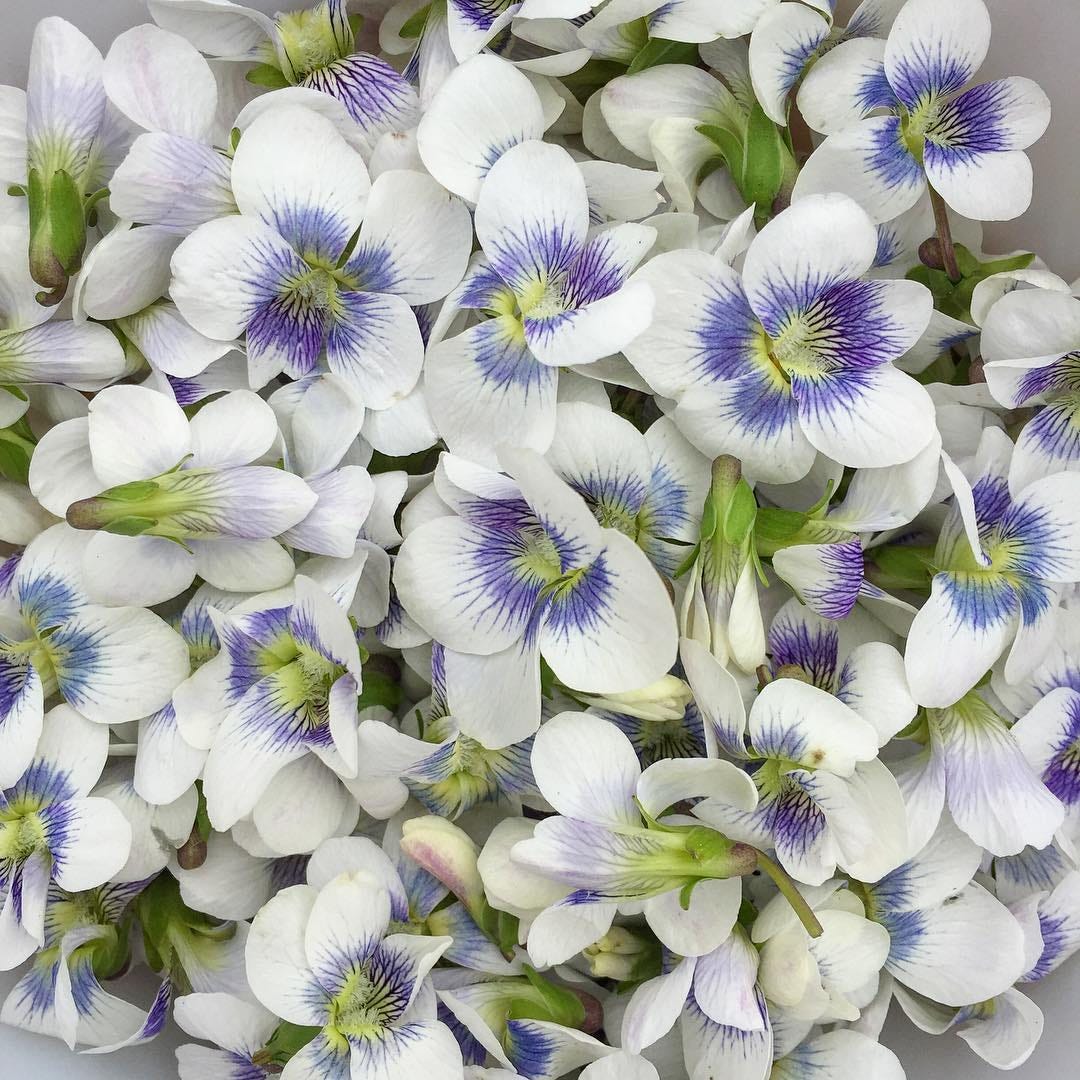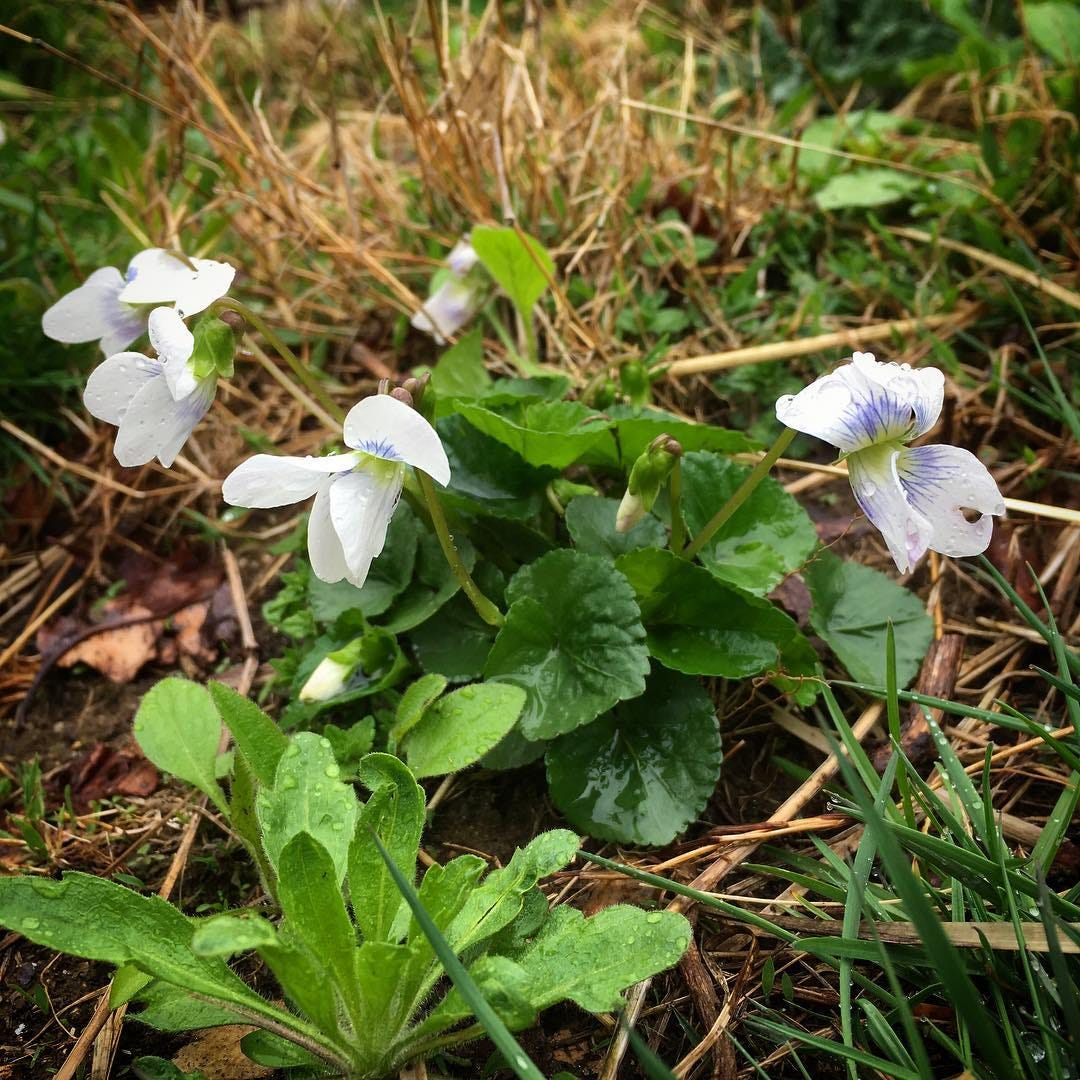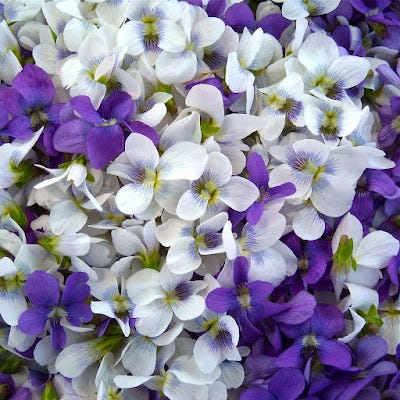Meet Viola spp. – Violet
Family: Violaceae
The Viola species is the largest genus in this family, with claims of 400 to 600 species worldwide.
Common species around my little acre seem to be Viola canadensis, Viola sororia, Viola labradorica – or so it seems, and others. Some local herbalists use Viola odorata to name the blue violets I have growing, but I’m uncertain if this European species is correct since I don’t find any of “my” violet flowers to be aromatic as V. odorata is described. I’m always exploring and learning, and perhaps one day I’ll know for sure. Nonetheless, I bless and leverage all the Viola species I have growing around me, by any name, as Food and as Medicine.
The flowers we observe in springtime are not reproductive, as they don’t produce seed. Rather, the “true” reproductive flowers of this plant show up later in summer, hidden by the protection of the leaves, and often go unnoticed by the uninitiated.
The flowers range from deep purple, lilac, pale rose and white, and there’s the multi-colors of Viola tricolor, the violet commonly called Johnny Jump up and heartsease, at least around these parts.
The leaves of Viola are typically heart shaped (or lung, or breast shaped when turned around), and this descriptive detail speaks to the signature of the plant. The flowers have five petals, four reaching up and out, and one broad, lobed petal at the bottom. The details of the shape and placement of the petals is often used to define and differentiate the many species.
Harvest: Flowers, leaves, roots. Spring to summer.
Taste: Sweet, bitter.
Humors/Energetics: Cool, moist
Actions: Alterative, anti-inflammatory, astringent, bitter, demulcent, diuretic, emetic (roots) expectorant, lymphatic.
Constituents: Flavonoids, methylsalicylate, mucilage, phenolic glycocides, methylsalicylate, rutin, saponins. Various minerals, vitamins A and C, and more.
Contraindications: There’s always the possibility of an allergic reaction, but I’ve not yet met anyone having or claiming to have an allergy to this botanical, and there are no documented contraindications or drug interactions.
Uses: Many of the violets have a long tradition of use for respiratory challenges, especially in treating bronchitis. Violets have also been leveraged for calming the symptoms of urinary tract infections, and as a long-term treatment for varieties of rheumatoid conditions. Also, they’ve been used, internally and externally, for addressing dry skin conditions, including eczema, and are honored for having an affinity with breast health. In my experience, as well as research/observation, it seems it’s the leaves that are most leveraged.
Internal
From the perspective of using the herb internally, I suppose I consider violet first as Food, then as Medicine. I tend to harvest the blossoms in spring to add to salads, and to infuse in vinegar, and sometimes in honey, or in syrup-making. The infused honey can be stored away and used in winter as is, added to hot water or tea, or as a demulcent addition to syrups or tinctures formulated for dealing with a dry or sore throat, or dry cough. A spoonful of a lovely, infused honey has been declared pre-performance support by a singer and a couple speakers I've known. For what it’s worth, I find the leaves even more worthy in this regard.
And while I’ve honored its signature relationship with heart, lungs and breast that the leaves express, this is primarily how I’ve leveraged violet over the years – as nourishing and nurturing Food and beverage. So, it’s fun to revisit it, to see what I’ve been missing, consciously or otherwise.
Rosalee de la Forêt mentions that “Another name for violet is hearts-ease. It has been used for the physical and emotional heart for thousands of years. Violet is high in a constituent called rutin. Rutin strengthens capillaries, prevents platelet aggregation, and is anti-inflammatory.”
The constituent methylsalicylate speaks to the platelet aggregation, anti-inflammatory, and pain relieving qualities that it offers; actions which hold relationship with heart health, and holistically so. Consider that, the holistic bit, and then revisit the consideration when we get to the Spiritual uses. *nods*
Historical references make note of violet being useful in treating various cancers, or the symptoms we currently associate with such diagnoses. To me, these mentions offer added validation of its use as Food and beverage, as well as Medicine (and as an infused oil for topical use, which we’ll get to in a moment).
In an article on violets, Jim McDonald quotes Paul Bergner as saying, "In medieval Baghdad, the “license” to practice medicine was given as permission to practice in the marketplace… One of the rules was that an individual would be disqualified from the practice of medicine if they were observed to 'use a strong herb when a mild herb would suffice, used an herb when a food would suffice, or use a food when simple advice about lifestyle would suffice.”
I feel like Viola reminds us of this Good Medicine advice.
External/Topical
I harvest the leaves to dry and have on hand for tea blending throughout the year, and with my dry constitution (and dry skin) I tend to focus on collecting the leaves for infusing in oil. I use the oil for a loving breast massage, and for all-over body use, as is or blended into a soft balm. The infused oil is a favored base for my soaps, as its skin softening qualities shine through even after the alchemical magick of cold-process soap making. The oil often finds its way into many of my skincare creations, and I’ll often slather it over my entire body after bathing. I just love the feel of it on my skin.
Because of its skin softening actions, it’s a great for rough spots, like heals ‘n’ elbows, and why some folks love it for managing their psoriasis or eczema. I have found it to be helpful for reducing, and sometimes resolving stubborn keloids. I like it blended with an infused oil of comfrey leaf for my well-used (abused?) gardening hands and cuticles, especially – I find – in a balm with a touch of lanolin added.
A poultice of the fresh leaves has a reputation for dissolving hard tissue, lumps and cysts, with a special affinity for the breast. The poultice has a reputation for unclogging clogged milk ducts too. Also, David Hoffmann makes reference to its use in treating cradle cap in babies.
The fresh leaf poultice, infused oil, and the inclusion in teas and nutritional water 'n' vinegar infusions were – together – a comforting Medicine of mine during a mysterious breast issue many moons ago now. I credit the unassuming power of the plant (along with the fierce might of goddess Kali) with what I can only call a positive outcome. ::nods::
The fresh leaf poultice is also credited with addressing a number of skin challenges, including infected wounds, acne, keloids, eczema, psoriasis, etc. I’ve engaged the leaf many a time, rolled and smashed between my fingers to cool and soothe the irritations and bug bites ‘n’ stings that happen while in gardens. Also, I’ve seen positive results from direct use of the fresh plant on those previously mentioned stubborn keloids.
Not only is a poultice of fresh leaf honored with supporting these skin issues, but also in cooling and soothing arthritic inflammations, and swollen glands.
It’s because of these external applications of the fresh plant matter that, when I remember, or am inspired, I make a pesto of the fresh leaf to keep in the freezer for the potential off-season need for a poultice. So, for the sake of clarity, we’re freezing it to thaw to use as a topical poultice Medicine, not to eat (though you certainly could).
I harvest the leaves, too, for dehydrating to use for making a nutritional herbal infusion in the Wise Woman Tradition, as well as adding it to tea blends. It’s a perfect match-up for me, what with my personal constitution that tends to wax hot ‘n’ dry.
I rarely use Viola in tincture form, though I keep some on hand for a gentle lymph support, alone or blended with calendula, or to temper and soothe the sharpness of poke berry or root tincture (which is HUGE Medicine that is used rarely, with specific reason, and with grande respect). Alone, like calendula, I often use it after core symptoms of an illness subside, but persist just under the surface. Know what I mean? To me, it’s when the body needs a little support in flushing out the waste after an illness, and I find this approach especially useful after a cold, flu, or other yuk leaves me (or others) with that feeling of not fully bouncing back to the familiar state of harmony. Dosing is personal, but I typically use a modest squirt from a dropper (like a ½-inch or so), direct in the mouth, or in a glass of water or cup of tea, 3-5 times a day for just a couple/few days. David Hoffmann suggests 1 to 2 ml three times a day. Trust your guidance.
Spiritual
I’ve witnessed this herb as a supportive ally for addressing deep, obsessive grief or trauma, the kind of that detaches one from the joys of everyday life.
Sitting with the blossoming plants in spring – a grounding act in and of itself – can nurture and restore a connection with the present moment, with simple pleasures, with forgiveness, and with gratitude. Carrying a bit of dried herb, or a bead made from the botanical, in a pocket or pouch can nurture these healing offerings, as well as engaging the Medicine of a flower essence, or in spiritual bathing with blooms and/or leaves are all practices that carry special healing power. Maude Grieve shares this tidbit of validation, “violets, like Primroses, have been associated with death, especially with the death of the young. This feeling has been constantly expressed from early times. It is referred to by Shakespeare in Hamlet and Pericles and by Milton in Lycidas.”
I have found such simple and classic use of this plant to be very supportive when I feel a need to reestablish or bolster a sense of safety and trust.
Dance with the Viola species – Violets!
As with all of our botanical friends, invite violets to ignite your imagination, intuition, and inspiration to nurture and nourish a meaningful relationship with its Medicine.
Infused blossom vinegar – for a lovely, delightful tonic to use with salads, vegetables, as an addition to cooking cruciferous greens, to splash on bean soup before serving, in marinades, or added to water with a touch of sweetener (or salt) for a quenching beverage. And, of course, you can add honey to the infusion to create a violet oxymel (or cane sugar for a shrub).
Collect your blossoms, fill a jar loosely with them, cover with vinegar. A living apple cider, rice vinegar, and white wine vinegars tend to be my current preferences. Label your jar and and allow it to macerate 4-8 weeks. Strain, bottle, label and enJOY!
Infused honey – to use as a sweetener for beverages and foods, to use as a base for syrups, to add to your violet blossom vinegar to create a doubled-up violet oxymel.
As with the infused vinegar, collect your blossoms (and/or leaves, chopped), fill a jar with them, cover with honey (ideally, local and unprocessed), label and enJOY! You’ll notice the straining is missing here, as I leave the plant matter in my infused honey. Your mileage may vary.
Tincture
FPM (Fresh Plant Matter) – I fill a jar with fresh plant matter (flower, leaf, both, gently wilted or fresh), ideally chopped, and cover it with 50% by volume ethanol (I most often reach for vodka). Cap, label, and allow to macerate, out of direct sunlight, for 4 to 8 weeks. I give mine a loving/healing shake now and then throughout that time. Strain, filter if desired, bottle and label.
DPM (Dried Plant Matter) – I add one ounce of dried plant matter to a quart jar and fill it with 40% by volume (80 proof) vodka, which is easy to procure organic, which is always my preference. You may use any ethanol alcohol of your choice, diluted - iff needed - to that 40% range). Cap and label, and allow it to macerate, out of direct sunlight, for 4 to 8 weeks. Strain, filter if desired, bottle and label.
DOSING is so personal, and to me dosing more about the person than the plant, which is why folks are often more confused after my class on dosing than they were before it… that is, until they have some experience with the Medicine. All the same, on those rare occasions when I use the tincture, I’ve used drop and dropper dosing, 3 to 5 times a day, always trusting that inner voice, and my experience.
Side note/Random thought: To me, Medicine making, like dosing, is so personal. As herbalists, we all follow certain shared protocols, yet we all have our own ways, and that’s as it should be. As The People’s Medicine, it belongs to us, individually and collectively. So we have choices to honor and leverage the resources around us, in the moment, in any way we’re inspired, when needed or desired. And those choices are Good Medicine too. Engage your free will, your familial traditions, your capacity for critical thinking, and make juicy choices that resonate deeply.
Homemade Violet Jelly adapted from TheNerdyFarmWife.com
2 to 3 cups loosely packed violet blooms, calyxes removed, or not (I leave them intact)
Juice of one large lemon
2½ cups boiling water
1 package of powdered pectin (I typically use Sure-Jell)
3½ cups sugar
Make a violet infusion pouring boiling water over your violet blossoms and let steep until cooled to room temperature.
Strain the violet juice (compost the plant matter) and add the lemon juice.
Mix the pectin with your violet/lemon water and stir over high heat until it reaches a heavy boil.
Boil for one minute more and add the sugar all at once.
Keep stirring until it returns to a solid boil and continue stirring for one minute.
Remove from heat, Skim off any foam, and ladle into hot, sterilized jelly jars, leaving about 1/8” head space, cap and process in a water bath for ten minutes. Remove from water and let sit for 24 hours to ensure the seals are set.
Violet Ice Cream – adapted from Rosalee de la Forêt - herbalremediesadvice.org/violet-recipes.html
pinch of dried butterfly pea (Clitoria ternatea), or spiderwort (Tradescantia sp.) flowers - optional
2 cups milk of choice, divided
1 cup violet syrup
2 eggs
Infuse the butterfly pea flowers in 1 cup of the milk over low heat for about 10 minutes or so, until the color comes through. Strain.
Pour the infused milk into a bowl and add the other cup of milk and the violet syrup.
In a separate bowl slightly beat two eggs. Add them to the milk, mix until well blended (I use a handheld electric blender for this).
Refrigerate for at least an hour and then follow the directions for your ice cream maker.
Some of the typical and atypical applications…
Tea/Infused water/ales and other fermented beverages
Use the flowers to decorate a spring cake, or embellish icing on any baked goodie
Tea sandwiches (or any sandwich)
In salads
Add flowers to ice cubes
Infused vinegar
Infused liqueurs
Infused honey (flowers)
Sugars
Candied flowers
Infused oil (leaves)
Balms, ointments, lotions, soaps
Steams
Bathing/washing (leaves)
Bath and culinary salts
Medicinal pesto (for external application)
Poultices/compresses
Beads, pendants, talismans
Spiritual healing (especially for addressing deep, obsessive grief)
resources:
David Hoffman, Medical Herbalism
Henriette Kress, Practical Herbs
Jim McDonald, herbcraft.org
Maude Grieve, A Modern Herbal
Rosalee de la Forêt, herbalremediesadvice.org, Alchemy of Herbs
Susun Weed, Breast Cancer? Breast Health! The Wise Woman Way
Wikipedia for the botany bits
Personal notes from multiple sources
Personal experience
Peace. 🕊











